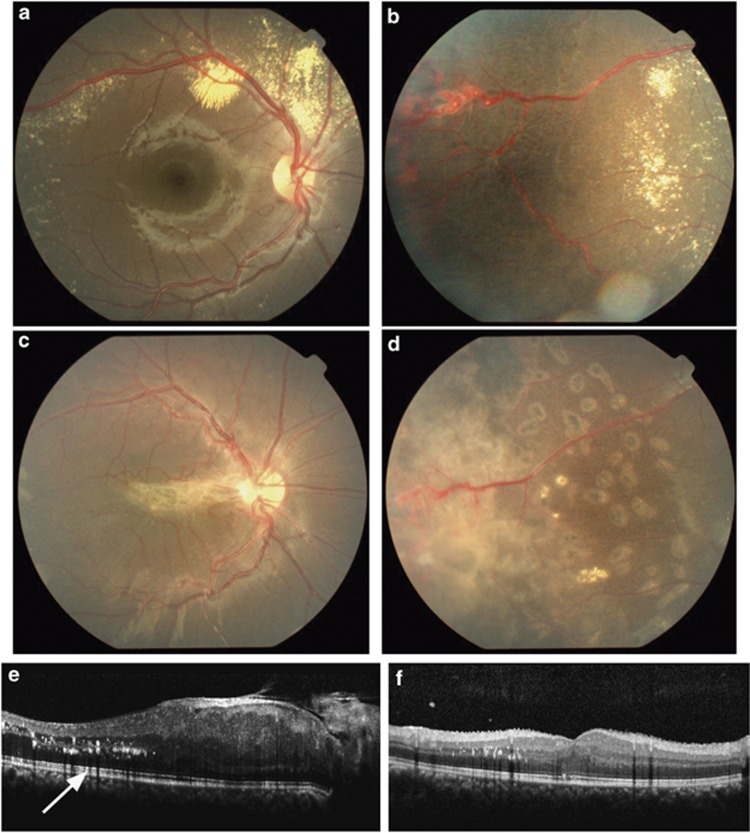Sir,
We report the management of an epiretinal membrane secondary to treatment of juvenile Coats' disease by 23-G vitreous surgery.
Case report
A 10-year-old boy was diagnosed to have right eye (OD) Coats' disease on routine eye examination. The vision in both the eyes was 20/20. The OD fundus examination showed extra foveal subretinal exudates in all the four quadrants, and dilated and telangiectic vessels in the inferotemporal quadrant (Figures 1a and b). The left eye fundus was normal. Three sittings of laser and cryopexy over a period of 2 years led to the absorption of the subretinal exudates and elimination of the telangiectatic vessels (Figure 1c). The vision decreased over a period of 5 months to 6/24 due to the formation of a thick epiretinal membrane (Figure 1d). The patient underwent spectral domain optical coherence tomography (SDOCT), which showed a thick hyper reflective epiretinal membrane, with intact inner segment/outer segment (IS/OS) junction (Figure 1e). The patient underwent 23-G minimally invasive vitreous surgery with a high speed cutter (constellation vision system, Alcon). The epiretinal membrane (ERM) removal by forceps helped in inducing the posterior vitreous detachment. No intraocular dye was used to stain the ERM. The postoperative SDOCT at 3 months showed a near-normal foveal contour (Figure 1f). The vision improved to 20/20 after the procedure.
Figure 1.
(a) Subretinal exudates seen, sparing the fovea. (b) Dilated telangiectic vessels, focal aneurysms, and subretinal exudates in the temporal quadrant. (c) The fundus photo showing thick epiretinal membrane. (d) The temporal periphery showing laser marks and reduction in the caliber of the dilated and telangiectic vessels. (e) The preoperative SDOCT image showing ERM, the loss of foveal contour, and a well-maintained IS/OS layer (arrow). (f) Three months postsurgery, the foveal contour has improved.
Comments
Coats' disease is a unilateral exudative retinopathy, more commonly seen in males.1, 2 Retinal photocoagulation/cryopexy can lead to premacular fibrosis. ERM is a rare cause of visual loss in Coats' disease. In two large case series, ERM was noted in 2.5–4.4% of the cases,2, 3 but there was no mention of any treatment for the ERM. Only one case report, till date, shows good anatomical and visual improvement after vitrectomy and ERM removal in a case of adult onset Coats' disease.4 There is no report of vitrectomy being performed for secondary ERM in a patient with juvenile Coats'. Our case did well after vitrectomy and ERM removal; thus, patients having ERM should be given the benefit of early surgery.
The authors declare no conflict of interest.
References
- Morales AG. Coats' disease. Natural history and results of treatment. Am J Ophthalmol. 1965;60:855–865. [PubMed] [Google Scholar]
- Rishi P, Rishi E, Uparkar M, Sharma T, Gopal L, Bhende P, et al. Coats' disease: an Indian perspective. Indian J Ophthalmol. 2010;58 (2:119–124. doi: 10.4103/0301-4738.60081. [DOI] [PMC free article] [PubMed] [Google Scholar]
- Shields JA, Shields CL, Honavar SG, DeMirci H. Clinical variations and complications of Coats' disease in 150 cases: the 2000 Sanford Gifford memorial lecture. Am J Ophthalmol. 2001;131:561–571. doi: 10.1016/s0002-9394(00)00883-7. [DOI] [PubMed] [Google Scholar]
- Shukla D, Chakraborty S, Behera UC, Kim R. Vitrectomy for epimacular membrane secondary to adult-onset coats' disease. Ophthalmic Surg Lasers Imaging. 2008;39 (3:430–431. doi: 10.3928/15428877-20080501-15. [DOI] [PubMed] [Google Scholar]



